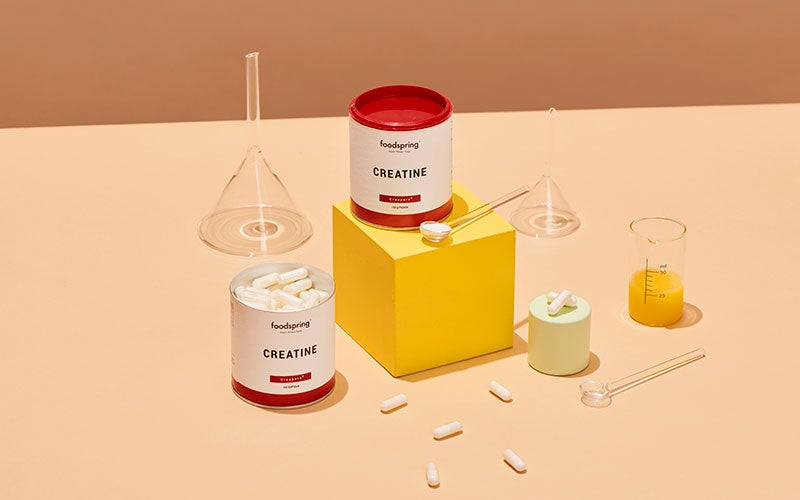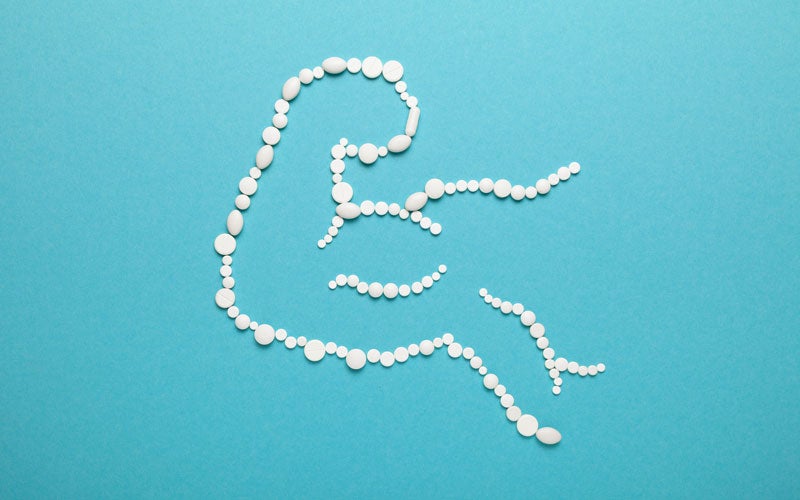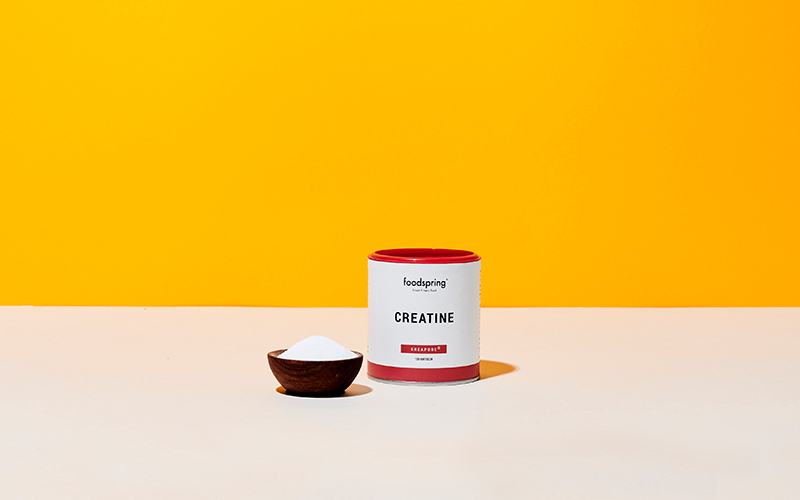What is Creatine and What to know about it
 ©foodspring
©foodspring
What is creatine? Short answer: it’s best known as a dietary supplement in powder or capsule form. For the long answer about how it works and everything else you need to know about taking creatine supplements: keep reading.
What Is Creatine?
Creatine is a carbon-nitrogen compound (making it an organic acid) that’s important for your muscles. The body can produce it by itself out of the amino acids glycine, arginine, and methionine.
The body stores a maximum of 5 grams of creatine per day. Anything that you ingest beyond that isn’t used, but broken down and excreted by your kidneys instead. Your body creates 1-2 grams by itself, while the rest is absorbed from food. Fish and meat are the most significant sources of dietary creatine. Salmon, beef, and pork all have about 0.5g per 100g.
About 90 percent of your creatine supply is stored in your muscle cells. Here, it plays a major role in the short-term power of your muscles’ type 2 fibers (also known as fast-twitch fibers), which are responsible for explosive strength. So whether you’re lifting a heavy dumbbell during a bicep curl or running a 100-meter sprint, you owe a good chunk of your performance to creatine.

What Effects Does Creatine Have?
When the body absorbs creatine through food, or supplements like capsules and powder, most of it is converted into creatine phosphate. This phosphate’s task is to transport the body’s energy supplier adenosine triphosphate (ATP) to the muscle cells in the fast-twitch fibers. The greater the supply of creatine, the more energy is available to the muscles over the short term. The effect: Your muscles can contract faster and work more effectively.
Taking creatine supplements can help you increase your performance in intensive rapid strength exercises, for example during sprints or dumbbell exercises. However, the body can only store a maximum of 5 grams of creatine per day, which means any increase in performance has a natural limit.
Every body is different, so each athlete will feel the effect of creatine differently. Vegetarians or vegans, for example, usually feel stronger effects when they take creatine supplements, since they hardly get any in their diets. The subjective increase in performance can therefore be greater for someone who eats neither meat nor fish.
Don’t forget: Creatine supplements increase your body’s performance in rapid strength exercises during short-term, intensive physical activity. This effect will only be felt by adults involved in intense sport activity who get at least 3 grams of creatine daily.
©foodspring
Creatine and strength training
Is building strength and muscle mass your fitness goal? Then your muscles need one thing above all else: energy, i.e. ATP. When the energy stores in your muscle cells are exhausted, creatine phosphate comes into play: It provides fast-twitch muscle fibers with new ATP at short notice.

Creatine and increasing mass
Creatine can supply your muscles with quick energy, so that you have more power available for fast, explosive loads. If you have enough creatine available, the muscle doesn’t get tired so quickly, so you can keep going longer in training and manage that one extra rep or another kilo. This also means that you’ll get more growth stimuli for increasing your muscle mass.
If you are looking for muscle volume, creatine can help you out for another reason: It binds water in your muscle cells. But there’s no need to worry: any “bloating” you’ve heard of as one of creatine’s side effects is just a myth. It’s only your muscle cells that gain volume.
The volume of your biceps, glutes, and other important muscles increases, but, strictly speaking, it’s not actual muscle mass of course. It’s just on the surface that your muscles look bigger. In the initial weeks of a creatine supplement program, you can gain up to three kilograms.

Creatine’s side effects
Creatine is one of the most frequently studied nutrition supplements. There’s hardly another supplement that scientists have looked into as intensively as this muscle fuel. According to a current study, taking 3 grams of creatine per day is safe and harmless for adults when taken over the short and long term6.
Only a daily intake of this amount in adults will lead to increased physical performance in rapid strength exercises during short-term, intensive physical activity.
High doses of creatine (more than 20 grams per day) over a longer period of time lead to a risk of negative side effects such as abdominal pain, diarrhea, and vomiting. Side effects on other organs have also been observed. Since excess creatine has to be broken down by the kidneys, people with kidney disease or an increased risk of kidney disease (e.g. diabetes, high blood pressure) should be careful not to exceed the recommended amount per day.

If you see a doctor for any reason, be sure to mention you are taking creatine. If you leave this information out, it can lead to false diagnoses, as increased creatine levels in the blood can be an indicator of impaired kidney function.
Taking Creatine
Who should take creatine, how much, with what, and when? This section has everything you need to know about taking creatine supplements.

Creatine dosage and duration
In general, 3 grams of creatine are recommended per day. Of course, not everyone is built the same. So you can also calculate your individual dosage with the formula 0.03 grams of creatine per kilogram of body weight.
For the greatest possible effect in terms of mass and strength building, many athletes rely on an intensive creatine phase tailored to their training plan. We recommend daily supplementation over a period of 3 to 6 months.
Check on your training progress after this phase and see if you can feel the effects you were going for.
What time to take creatine
You can take creatine supplements either after waking up or right before your workout. The time of day isn’t as important as the context.
We recommend taking creatine with fruit juices like apple or grape. Meanwhile, avoid taking creatine alongside caffeine or alcohol.
Creatine Sources
Fish and meat are the best sources of creatine, although the content is still relatively low. To get 5 grams of it, you would have to consume about 1 kilogram of beef. Dairy products contain even smaller amounts, plant-based products have hardly any at all. Therefore, vegetarians and vegans usually have lower creatine levels than omnivores.
How much creatine is in which food?
| Food | Creatine per kg |
| Herring | 6.5-10g |
| Pork | 5g |
| Beef | 4.5g |
| Salmon | 4.5g |
| Tuna | 4g |
| Cod | 3g |
| Plaice | 2g |
| Milk | 0.5g |

©LauriPatterson
Creatine in Dietary Supplements
Many athletes may benefit from supplementing with creatine. The following products are on the market:
Creatine monohydrate
The standard dietary supplement is creatine monohydrate, which is the most studied form and, according to current research, the most effective.
Many manufacturers, including foodspring, rely on Creapure®, a raw material that is produced exclusively in Germany and recognized worldwide, for their creatine monohydrate. Creapure® dissolves easily and has the highest degree of purity.
Other forms of creatine
- Buffered creatine (or Kre-Alkalyn): contains sodium carbonate
- Creatine HCL: contains additional hydrochloride
- Creatine Citrate: contains additional citric acid
- Creatine Malate: contains malic acid
- Creatine Magnesium Chelate: contains additional magnesium
- Creatine Pyruvate: contains additional pyruvate
- Creatine Nitrate: contains additional nitrate
Conclusion
- Creatine is responsible for transporting energy in the muscles.
- Per day the body synthesizes 1-2g of creatine itself and can store up to 5g.
- Creatine is mainly found in fish and meat, but only in small doses, which is why supplements can address possible deficts.
- Creatine boosts fast-twitch and maximum strength, can contribute to regeneration, and increases muscle volume.
- The biggest side effect of creatine intake is water retention in the muscle cells, which can result in increased muscle volume and body weight.
- A daily intake of at least 3 grams in creatine supplements over a period of 3 to 6 months is safe and harmless for healthy adults.
- While various dietary supplements are on the market, the standard product is creatine monohydrate as powder or capsules.
- Supplements with creatine are not a replacement for a well-balanced and healthy diet, nor for a healthy lifestyle with regular exercise.
Sources for this article
We at foodspring use only high-quality sources, including peer-reviewed studies, to support the facts within our articles. Read our editorial policy to learn more about how we fact-check and keep our content accurate, reliable, and trustworthy.
- https://pubmed.ncbi.nlm.nih.gov/27328852/
- https://www.sciencedirect.com/science/article/abs/pii/S0024320504005211
- https://pubmed.ncbi.nlm.nih.gov/16025431/
- https://pubmed.ncbi.nlm.nih.gov/14741375/
- https://pubmed.ncbi.nlm.nih.gov/12044443/
- https://pubmed.ncbi.nlm.nih.gov/28615996/


































